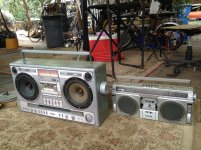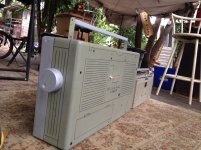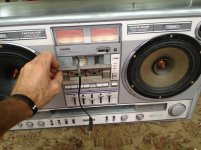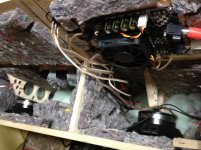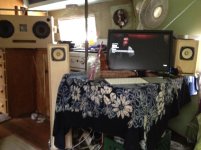And also: Here's my boominator for this year 
An externally hosted image should be here but it was not working when we last tested it.
Nice Rubennn!! I like the stickers 
I have some questions about my design. Its at back to back design with 2x HP-10T and 2x Piezo QLM-1005. Im going to use a ta2024 MKII (very cheap) If that isnt working good I'll use a AMP6b.
I use a closed cabinet with 12 liters volume. (14~liter - speakervolume 2~liter?)
The Qtc is 1,20. Good for outdoor use, right?
I wonder if it would be better to do like in the boominator, make holes in the middle. And do so the speakers share cabinet? Maybe this isnt good for the speakers in a closed cabinet? Idk x)
Sketchup:
Boombox HP-10T and QLM-1005 by Ohman92 - Google 3D Warehouse
Sorry for the bad quality.
I have some questions about my design. Its at back to back design with 2x HP-10T and 2x Piezo QLM-1005. Im going to use a ta2024 MKII (very cheap) If that isnt working good I'll use a AMP6b.
I use a closed cabinet with 12 liters volume. (14~liter - speakervolume 2~liter?)
The Qtc is 1,20. Good for outdoor use, right?
I wonder if it would be better to do like in the boominator, make holes in the middle. And do so the speakers share cabinet? Maybe this isnt good for the speakers in a closed cabinet? Idk x)
Sketchup:
Boombox HP-10T and QLM-1005 by Ohman92 - Google 3D Warehouse
Sorry for the bad quality.
An externally hosted image should be here but it was not working when we last tested it.
Please, can you draw a picture how i should do the wiring.
Thanks!
Sealed (closed cabinet) offers the highest power handling because the sealed cushion of air acts as a shock absorber to reduce x-max. Sealed also offers the cleanest or most cohesive bass when and if the woofer is made for sealed box use. And, it is good that they don't apply, else you'd need a much larger amplifier eq'd with speakers in a much bigger box.. . .Im going to use a ta2024 MKII (very cheap) If that isnt working good I'll use a AMP6b. I use a closed cabinet with 12 liters volume.. . . Good for outdoor use, right?. . .
Fortunately, those details are not applicable.
However, there is an 11 watt to 8 ohms amplifier and woofers for ported prosound application and those two details need better support than shown. Therefore, you may want a ported enclosure instead. Ported is more efficient, lower pitched, greater impact and more applicable towards maximizing the available eleven watts.
Nice Rubennn!! I like the stickers
I have some questions about my design.
You should certainly go ported. The hole idea of this boominator design and using so many speakers and large speakers is to achieve high efficiency. Ported(correctly) you will effectivelly have twice the power at the lower bass frequencies. For achieving maximum impact out doors this is essential. The ports must be correct! Details are in the thread.
The left and right channels need to be kept in there own enclosures of course.
You should certainly go ported. The hole idea of this boominator design and using so many speakers and large speakers is to achieve high efficiency. Ported(correctly) you will effectivelly have twice the power at the lower bass frequencies. For achieving maximum impact out doors this is essential. The ports must be correct! Details are in the thread.
The left and right channels need to be kept in there own enclosures of course.
But most of the people say that hp10t need to have closed cabinet? hmm this change alot.
Ok, but if I use a stereo to mono adapter and share cabinet? will it be better?
just finished this boom box! Dayton full range neodymium PS-220's, Pyramid tweeters (functional but really for looks @ only 90 dB SPL compared to the PS-220's 95 dB SPL), Sure TK2050 amp (100w x 2) provides about 35w cleanly, 12 mm Baltic birch and li-po 5aH battery. Designed with Eminence Speaker Designer, intuition, and aesthetics based on a vintage classic, the National RX-5053. It does 113 db before distorting. Sound is surprisingly close to my Frugelhorn MKIII's, with higher bass roll-off and some shouty, undefined, unseparated mids. Overall it sounds and looks better than I hoped. Weight is < 30 lbs.
Attachments
Last edited:
But most of the people say that hp10t need to have closed cabinet? hmm this change alot.
Ok, but if I use a stereo to mono adapter and share cabinet? will it be better?
Oh sorry, that's not the reference drive! I am not sure how to best use that driver sorry.
Its ok (; but.. if I do a Halfinator, then I need 1 port on each side. What size does it need to be? I dont understand the port-size system on WinISD... 
Im thinking of making a half halfinator (1x hp-10w & 1x qlm-1005). And go MONO.
Do I need a mono amp or can I use a regular ta202x with a stereo to mono
converter?
Im thinking of making a half halfinator (1x hp-10w & 1x qlm-1005). And go MONO.
Do I need a mono amp or can I use a regular ta202x with a stereo to mono
converter?
Compact "Solonator"?
In this case (1 of 8 ohm woofer), you'd use one channel of the amplifier. For mixer, you could use one pair of resistors (something like 1k) at the input as a stereo to mono mixer to send both channels of the source into one channel of the amplifier. It could be good short the unused amplifier channel to prevent it from using extra electricity unannounced (or buy a mono-only amp instead). The problem with using just one woofer is that you'd want four to eight times the power from the amplifier in order to keep up with the boominator. This is merely a task of amplifier shopping. Basically, you're looking for a 50w to 100w efficient switchmode amplifier on bass. That is going to run the one woofer at maximum power.
Good luck with the amp shopping.
You also have the option of running a ta2024 from a miniature low ripple DC-DC buck converter to provide treble in stereo and simply use extremely small input caps to the treble amp to cut off the bass from the tweeters (also use output caps to further steepen the crossover efficiency and so easily block dc). Crossover adaptation for the woofer--the inductor will be twice as big as boominator and the woofer shunt cap will be half as big since you're running 8 ohm instead of 4 ohm.
These ideas are all generalized, but should lead to making a very compact festival speaker. Personally, I'd try to further refine it by lowering the crossover point of the woofer (less beaming, clearer bass, P-Core or other big inductor in the woofer crossover) in order to employ a stereo pair of large size prosound horns for mid-tweet and thus more effective stereo. As a bonus of this bi-amp arrangement, you won't hear clipping since if the bass amp clips, your treble amp didn't necessarily do the same thing. The real big trick here is bass amp shopping since that 1 HP10W has to run at max to compete with the 4 HP10W's of boominator.
I hope this helps.
Its ok (; but.. if I do a Halfinator, then I need 1 port on each side. What size does it need to be? I don't understand the port-size system on WinISD...
I'm thinking of making a half halfinator (1x hp-10w & 1x qlm-1005). And go MONO. Do I need a mono amp or can I use a regular ta202x with a stereo to mono converter?
In this case (1 of 8 ohm woofer), you'd use one channel of the amplifier. For mixer, you could use one pair of resistors (something like 1k) at the input as a stereo to mono mixer to send both channels of the source into one channel of the amplifier. It could be good short the unused amplifier channel to prevent it from using extra electricity unannounced (or buy a mono-only amp instead). The problem with using just one woofer is that you'd want four to eight times the power from the amplifier in order to keep up with the boominator. This is merely a task of amplifier shopping. Basically, you're looking for a 50w to 100w efficient switchmode amplifier on bass. That is going to run the one woofer at maximum power.
Good luck with the amp shopping.
You also have the option of running a ta2024 from a miniature low ripple DC-DC buck converter to provide treble in stereo and simply use extremely small input caps to the treble amp to cut off the bass from the tweeters (also use output caps to further steepen the crossover efficiency and so easily block dc). Crossover adaptation for the woofer--the inductor will be twice as big as boominator and the woofer shunt cap will be half as big since you're running 8 ohm instead of 4 ohm.
These ideas are all generalized, but should lead to making a very compact festival speaker. Personally, I'd try to further refine it by lowering the crossover point of the woofer (less beaming, clearer bass, P-Core or other big inductor in the woofer crossover) in order to employ a stereo pair of large size prosound horns for mid-tweet and thus more effective stereo. As a bonus of this bi-amp arrangement, you won't hear clipping since if the bass amp clips, your treble amp didn't necessarily do the same thing. The real big trick here is bass amp shopping since that 1 HP10W has to run at max to compete with the 4 HP10W's of boominator.
I hope this helps.
You'll need a schottky diode in series with solar panel V+ in order to avoid using the solar panel as a battery powered heater or breakage or running the battery down whenever it gets dark.
You might want to consider a charge controller if the solar panel charges the battery unattended for more than 4 days. But unless given a very long time in the brightest of sunshine, a cute little 10w solar panel doesn't do much to a 38Ah battery.
A simple 1N4001 diode will also work in series with the panel. Most panels have it already built in, so I'd check the panel specs first before adding it, as a diode does have a ~1V drop across it.
For less than $20, you can add a simple charge controller, just make sure it's rated to handle your panel, which a cheap one should as a 10W panel will probably put out less than 1.5A. I've found very good deals on mono-crystalline panels at Amazon, and a mono- will make power even on a cloudy day much better than any other type.
I've got a 20W (1' x 2' panel) panel connected to a 9AH AGM-SLA battery on my small boombox and it will run for 3 years continuously (at 1/2 volume with a small 20W T-amp) according to my calcs. I've run it several days continuously without any problems, and still had a fully charged battery.
Anyway, a charge controller will keep you from overcharging or overdrawing the battery, which will make it last much longer.
Let me first say I absolutely LOVE, LOVE, LOVE this project and want to get started ASAP.
Sooooo, I have read about 100 pages so far and I still can't find a wiring diagram for the SLA battery, power switch and wall charger.
My main thing is I want to be able to charge the battery while it is plugged in and not overcharge it. Then when i go portable I just have to unplug from the wall. Is this possible?
Thanks
Sooooo, I have read about 100 pages so far and I still can't find a wiring diagram for the SLA battery, power switch and wall charger.
My main thing is I want to be able to charge the battery while it is plugged in and not overcharge it. Then when i go portable I just have to unplug from the wall. Is this possible?
Thanks
I would prefer to check the panel with an ohmmeter to find out if I needed a diode.A simple 1N4001 diode will also work in series with the panel. Most panels have it already built in, so I'd check the panel specs first before adding it, as a diode does have a ~1V drop across it.
If you check the datasheet forward voltage drop graph of MBR1035, it may lose only about 0.25v (depending on current use), so that is more efficient, but the simple diode arrangement is only useful when the amperage of the solar cell is so insufficient that it couldn't damage a battery (that approach uses a little solar cell with a big battery and takes a very long time to charge).
However, a finished charge controller product probably won't need the diode and I think that we would need the charge controller unit, instead, whenever the solar power to battery ratio could be aggressive enough to damage the battery (it seems that the charge controller is needed whenever a big solar cell is used).
Last edited:
SLA compatible "battery maintainer" float charger is the cord you're looking for.Let me first say I absolutely LOVE, LOVE, LOVE this project and want to get started ASAP. Sooooo, I have read about 100 pages so far and I still can't find a wiring diagram for the SLA battery, power switch and wall charger. My main thing is I want to be able to charge the battery while it is plugged in and not overcharge it. Then when i go portable I just have to unplug from the wall. Is this possible? Thanks
OH, the switch. You could use a SPDT on/on switch with the battery on center contact amp on top contact, charger on bottom contact. Turning it on disengages the charger and engages the amp. . . vs. . . turning it off engages the charger and disengages the amp.
Last edited:
I recommend switching an amp's mute signal instead of its power supply - if you switch the power supply, and there's a significant amount of capacitance in the amp (which there should be, really) you'll spark the contacts of the switch. Do it enough times and the switch will probably go flaky.
- Home
- Amplifiers
- Class D
- The Boominator - another stab at the ultimate party machine
